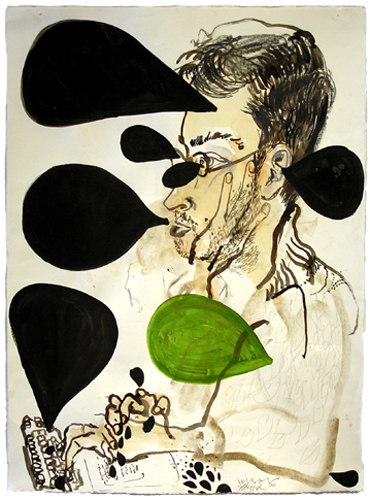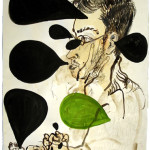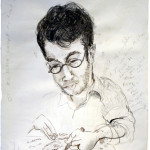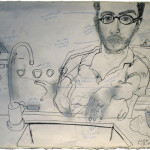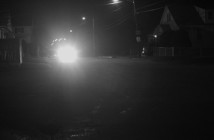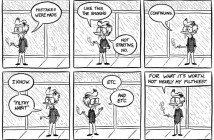SAM MESSER, HANGING CORRESPONDENCE @ NIELSEN GALLERY
Editor's Note: It's been pointed out that subject of the portraits discussed in this review are not Sam Messer, the creator of the works, but the author Jonathan Safran Foer. We apologize for mistake.
Sam Messer’s show “Hanging Correspondence” at The Nielsen Gallery deals with communication as a means of falsely experiencing reality.
The works are expressionist, exhibiting detail contrast as its key device, but surprising with delicious spurts of color. Each piece is a self-portrait, with the artist’s face in varying degrees of concentration, performing some type of activity - writing being the most frequent. Words and thought bubbles cloud the details of Messer’s face in many of the exhibition’s works, hiding him from the viewer. Some thought bubbles are blacked out and some fill the whole frame. When Messer’s drawing, his face is typically visible, but when he is performing domestic tasks, his face blends into the background. When he sits still, or closes his eyes, he is almost entirely obscured.
Five pieces in the show are duplicates of an image of Messer asleep. The first is basic charcoal, with an unreadable paragraph above his head. The second is a horrific charcoal piece with his eyes blacked out and a grotesque shape next to him - whether intestine section or slug is unclear. The third, a collaged version portrays him in front of a color photo of fish and another dark black & white photo of fish. Obscuring his body in this work are blue prints and crossed out words and the background is made up of stacks of black book with shocks of color. Messer’s beard has become a yellow and blue gag and his shirt is entirely usurped by scrawled text. We almost lose his image, but by the time we get to the last work, he is essentially lost in a smudged, two dimensional charcoal world, the only detail coming forward being a bizarre growth that protrudes from his mouth made of many collaged hands. Each work seems like a dream and most like nightmares. The title of all the sleeping pieces, Its always possible to wake someone from sleep, but no amount of noise will wake someone who is pretending to sleep, (2009), reverberates back through all of the pieces and evokes a hopeless, dispassionate feeling about everyday activities. The portraits are cold and lack enthusiasm for anything: Messer could be doing anything and his expression would not change.
The idea of humans obscured by reality and their attempts to communicate explains the title of the show, “Hanging Correspondence.” The noise referred to in the title of the sleeping portraits is the communication of reality and the pretence of sleep. A lack of direct experience leaves the viewer in a limbo of a communication simulacra that our culture has chosen instead of direct experience. The message is: you cannot stop us from mediating our experience through communications - in this age of intense live time communication, in the wake of Twitter, mobile devices and RSS feeds. We read everything we learn about the world on our screen. We read about what has happened, what will and what should. We watch videos for humor, chat for contact and post for ego stroking. Our experience has become digitized.
Messer has hit on an important issue with experiencing the world through a computer screen. Our direct experience of reality is eliminated – we dream the world. Computers put us into a waking life state. Dreams form based on our contextual programming and subconscious desires. Our experience forms on the net in a parallel way. We only experience what we click on. Similar to dreams, our experience of reality is dictated by our subconscious. Messer poses the question of whether we can be woken, an invaluable contribution to our culture’s self awareness.
- Sam Messer, Untitled, mixed media on paper, 2009.
- Sam Messer, Untitled, mixed media on paper, 2009.
- Sam Messer, Untitled, mixed media on paper, 2009.
"Sam Messer, Hanging Correspondence" is on view through 6 June 2009 at Nielsen Gallery.
All images are courtesy of the artist and Nielsen Gallery.

